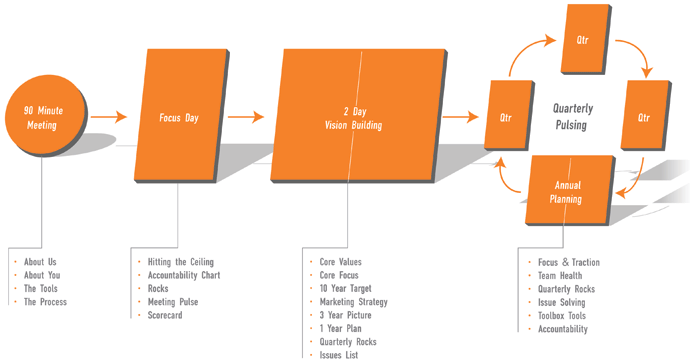If there’s one thing in this world that’s certain, it’s that one of the fastest ways to success is emulating the success of others. Implementing an EOS or entrepreneurial operating system has worked for over 40,000 companies around the world.
“Where attention goes, energy flows.”
What Does EOS Model Do for Business
In its simplest form, EOS gets all your arrows pointing in the same direction. In this case, the people in your business are the arrows pointing in different directions. This is normal, as everyone has their own way of working. With different goals and different schedules, most organizations operate like this. Now think about each of these arrows as energy or momentum. If you have all these arrows pointing in all sorts of directions, the company as a whole won’t really be moving forward or anywhere.
An EOS lines everyone up with the following:
Common goals
United focus
Movement towards a singular vision
This structure uses a plan and values to galvanize your workforce and the net result is business growth, control, and balance.
Considering Implementing EOS?
The entrepreneurial operating system has six key components of business which include the following:
Vision
People
Data
Issues
Process
Traction

The first decision is whether to:
Self-implement and choose to do it yourself or
Not to self-implement by going through the appropriate channels and getting a certified EOS implementer to come on board and train the team
An implementer isn’t cheap, and you’re essentially trusting your business to someone who might regard you as a total stranger. On the other hand, getting expert help is almost always worth the high fees, and getting it wrong could cost even more.
The Complications of EOS
A common pitfall is to only run EOS through the executive level of a business, leaving out the managerial and frontline levels to either save on time, money, or effort. It’ll be something that hurts the business in the long run. Getting some arrows to point in the same direction while leaving others to point in whatever direction they want, is not going to maximize performance. The EOS only works properly when everyone embraces it.
The only issue is in bigger companies, each department is going to have its own way of operating. Having the leadership team in sync and on the same page is crucial, but it’s useless if other levels of employees are still using their own methods of getting things done. Arrows pointed in different directions will cancel each other out and stagnate the business.
If some arrows can’t change direction, then the arrows are removed. Either you have the wrong people working for you and tough decisions have to be made as to whether they have a future in the business. Or on the other hand, you haven’t been assertive enough in building a culture that fully encompasses your company’s values and way of doing things. Middle management who aren’t using the EOS properly can start a cascading chain of insufficient training. The frontline workers downstream won’t know any better and use the EOS correctly. There may be a communication breakdown or a disconnect that prevents your staff from understanding what’s being taught to them. What you think you’re communicating, and what is actually being understood, can sometimes be miles apart.
The solution for the above is constant and updated management training. Explain what you want your staff to do from here on out. Make sure it’s repeated enough to sink in, and then question staff about the processes to make sure it’s comprehended. At the end of the day, you are restructuring how an entire company operates in its day-to-day activities. Instead of feeling frustrated at having to explain something multiple times, be appreciative that you’re aware that there is a breakdown in communication, and you get the chance to address and remedy it.
Here’s how self-implemented EOS can look:
Week 1: everything is set up and everyone is on board
Week 2: people get busy, and forget some action items on the to-do list
Week 3: the busy people get further off track, and more to-dos got missed
Week 4: half of the stuff that was meant to get done, didn’t get done
Week 5: the scoreboard and to-do lists get breezed through in the meeting because no one can be bothered to do them anymore
Lack of accountability is like cancer, once you let it spread, it will rip through your business like a disease. It’s important to utilize the 4 Disciplines of Execution or 4DX in order to execute the excellent strategy of EOS.
In order to be successful with your business, set an EOS model to reach business goals. This keeps you focused as well as your employees. This model can only work once everyone is onboard and held accountably. Make sure to have the EOS built out detailed in order to avoid miscommunication or the next thing you know, chaos can arise in all the departments.

